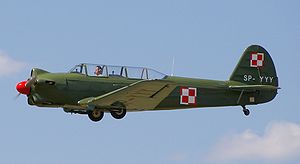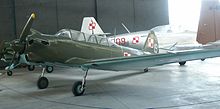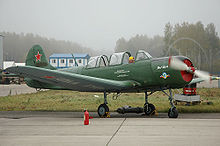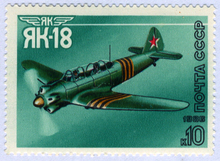- Yakovlev Yak-18
-
Yak-18 A Polish Yakovlev Yak-18 in flight Role Training aircraft Manufacturer Yakovlev First flight 1946 Introduction 1946 Primary users Soviet Air Force
DOSAAF
People's Liberation Army Air Force
Polish Air ForceThe Yakovlev Yak-18 (Russian: Як-18, also transcribed as Jak-18, NATO reporting name Max) was a Soviet tandem two-seat military primary trainer aircraft. Originally powered by one 119 kW (160 hp) Shvetsov M-11FR-1 radial piston engine, it entered service in 1946. It is also produced in China as the Nanchang CJ-5.
Contents
Design and development
A member of the second generation of Russian aircraft designers, and best known for fighter designs, Alexander Sergeyevich Yakovlev always retained a light aircraft design section. In May 1945, Yakovlev initiated design of the Yak-18 two-seat primary trainer. He designed it to replace the earlier Yakovlev UT-2 and Yak-5 in service with the Soviet Air Forces and DOSAAF (Voluntary Society for Collaboration with the Army, Air Force and Navy, which sponsored aero clubs throughout the USSR). In 1944, an advanced version of the UT-2 had been built and featured an enclosed canopy and fixed landing gear which bears a striking resemblance to the new Yak-18. The new aircraft flew a year later, powered by a 119 kW (160 hp) Shvetsov M-11 five-cylinder radial engine and featuring pneumatically operated retractable main landing gear and a fixed tailwheel. It entered service as a trainer later that year and was built by Yakovlev up until 1956. Examples were exported to China in kit form beginning in 1950. The Chinese began producing license built copies in 1954 with the designation CJ-5.
The Yak 18's greatest claim to fame is its use as a night bomber by the North Korean Air Force during the Korean War. The aircraft were modified with bomb racks on the wing center section and flew over UN troop locations at night to drop bombs and harass UN forces. The single most successful attack of the North Korean aviation during the war was destroying of a fuel dump with nearly 5.5 million gallons of fuel in Inchon area in June 1953 by 4 or 5 Yak-18s[1]. The five-cylinder engine reminded many of the US troops of the sound made by early gasoline powered washing machines earning them the name: "Washing Machine Charlie". The name "Bed Check Charlie" was also used for these night intruders. The Yak-18's along with Polikarpov Po-2's became quite a nusiance until US night fighters began shooting them down.
Other claims to fame for the Yak-18 are an international speed record for class in 1951 as well as being the aircraft used for initial flight training by Yuri Gagarin (1st human in space) and Ken Rowe (No Kum-Sok: defected with a Mig-15 during the Korean War). Later, as the need for conventional landing gear trainers abated Yakovlev re-designed the Yak-18 with retractable tricycle landng gear and a Ivchenko AI-14RF radial, 224 kW (300 hp) and was designated the Yak-18A. The design proved exceptionally easy to build and maintain.
There are an estimated 40 original Yak-18's in existence worldwide. Three are currently flyable in the USA and three are flyable in Europe. Approximately four other aircraft worldwide are currently being restored for flight. Many are found in major aviation museums worldwide including the National Air and Space Museum in the USA. The CJ-6a, produced in China, is sometimes quoted as a variant but is a completely different aircraft designed in China by Bushi Cheng and built by Nanchang Aircraft Company.
Operational history
The Yak-18 became the standard trainer for Air Force flying schools and DOSAAF, is in wide use[citation needed] in China, and in many other countries.
Variants
Polish Air Force Yak-18 in the Polish Aviation Museum
- Yak-18
- The original production version.
- Yak-18A
- Re-engined version, powered by a 194 kW (260 hp) Ivchenko AI-14 FR engine. Built in large numbers.
- Yak-18U
- This version was built in small numbers, but it had retractable tricycle landing gear.
- Yak-18P (NATO reporting name Mouse)
- Single-seat aerobatic aircraft for use by flying clubs. Adaptation of Yak-18 two-seat trainer.
- Yak-18PM
- Aerobatic aircraft.
- Yak-18PS
- Aerobatic aircraft with retractable tailwheel.
- Hongzhuan-501 (Red Craftsman)
- Probable original designation for early CJ-5 production aircraft.
- Nanchang CJ-5
- The Yak-18 was built under licence in China as the CJ-5 for use by the PLAAF, PLANAF and civilian flying clubs. 379 CJ-5's had been built when production ended in 1958.
Similar model designation
The Yak-18T was developed as an Aeroflot training aircraft and also as a light passenger transport aircraft, with a 4-seat cabin for one pilot and three passengers. It is not a variant of the Yak-18 as it has very little in common, and was designed from scratch 20 years later.
Operators
- Afghan Air Force - 14 acquired from 1957 and retired by 2001.
- Albanian Air Force - 43 (including Chinese CJ-6 variants).
- People's Liberation Army Air Force - manufactured in China under the designation CJ-5.
- Czechoslovakian Air Force
- East German Air Force
- Mongolian People's Air Force
- North Korean Air Force
- Romanian Air Force - 17
- DOSAAF
- Soviet Air Force
- Yemen Air Force
- Military of Zambia
Specifications (Yak-18A)
General characteristics
- Crew: two, student and instructor
- Length: 8.35 m (27 ft 5 in)
- Wingspan: 10.60 m (34 ft 9 in)
- Height: 3.35 m (11 ft 0 in)
- Wing area: 17.8 m² (191 ft²)
- Empty weight: 1,025 kg (2,255 lb)
- Loaded weight: kg (lb)
- Max takeoff weight: 1,320 kg (2,904 lb)
- Powerplant: 1 × Ivchenko AI-14RF radial, 224 kW (300 hp)
Performance
- Maximum speed: 300 km/h (187 mph)
- Range: 700 km (436 mi)
- Service ceiling: 5,060 m (16,596 ft)
- Rate of climb: m/s (ft/min)
- Wing loading: kg/m² (lb/ft²)
- Power/mass: kW/kg (hp/lb)
See also
- Related development
- Nanchang CJ-6
- Yakovlev Yak-20
- Aircraft of comparable role, configuration and era
- Zlin Trener
- LWD Junak
- De Havilland Chipmunk
- Percival Prentice
- Ryan Navion
References
- ^ Richard P. Hallion (1986), The Naval Air War in Korea, ISBN 0-933852-47-9, p.186
External links
The initial version of this article was based on material from aviation.ru. It has been released under the GFDL by the copyright holder.
Yakovlev aircraft Early aircraft Fighters Bombers Transports Reconnaissance Helicopter Yak-24 · Yak-100Trainers Experimental EG · Yak-5 · Yak-8 · Yak-13 · Yak-16 · Yak-19 · Yak-25 (I) · Yak-26 · Yak-30 (I) · Yak-36 · Yak-41 · Yak-43 · Yak-44 · Yak-46 · Yak-50 (I) · Yak-60 · Yak-140 · Yak-1000PLAAF/PLANAF trainer aircraft Lists relating to aviation General Aircraft (manufacturers) · Aircraft engines (manufacturers) · Airlines (defunct) · Airports · Civil authorities · Museums · Registration prefixes · Rotorcraft (manufacturers) · TimelineMilitary Accidents/incidents Records Chinese military aircraft Fighters J-20* · Shenyang J-19* · Chengdu J-2X* · Shenyang J-16* · Shenyang J-18* · J-10B* · J-11B · J-10 · YFC-1E · JF-17 · JH-7B* · JH-7 · Su-30MK2 · Su-30MKKBombers AEW and AEW&C Tankers Reconnaissance Transport StrategicTacticalTrainers Helicopters UAVs Shenyang Darksword* · Soar Dragon* · Chengdu Xianglong* · Sky Wing UAV* · Combat Eagle UAV* · Long Haul Eagle UAV* · Thunderbolt UAV · Yilong UAV · CH-3 UAV · CH-1 UAV · Xianglong UAV · WZ-2000 · BZK-005 · WuZhen-5 · ASN-206 · ChangKong-2 · ChangKong-1 ·- = Under development
Italicized = Retired or cancelled
List of Chinese aircraft
Categories:- Low wing aircraft
- Propeller aircraft
- Single-engine aircraft
- Soviet military trainer aircraft 1940–1949
- Soviet civil trainer aircraft 1940–1949
- Yakovlev aircraft
- Military aircraft of the Korean War
- Aerobatic aircraft
Wikimedia Foundation. 2010.






